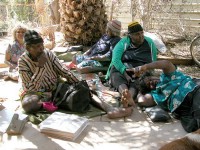It's always interesting to read about the beginnings of your method. You write about 'a woman sitting under a tree sewing'. That's obviously outdoors. From the bush camp and other activities, it seems clear that you often make in the open air. I'm curious to know more about working outdoors. What is important for you?
- Encounters with strangers
- Proximity to nature
- Openness to contact, particularly from Aboriginal women
- Fresh air
Of course, there would be problems also, to do with the weather and access to materials. But what outweighs these problems?
You also write about learning the Ngaatatjarra language, and that 'the map of my mind was completely renamed'. Do you have an example of this? Is there a case where the Ngaatatjarra word has directly influenced your work?
And as this dialogue is called Fodder, I thought I'd through a word in a food for thinking about materiality and making with fibre:
ret (ret) verb tr.
To soak or expose to moisture (flax, hemp, etc.) to remove fiber from softened wood.
[From Middle English reten, perhaps from Middle Dutch.] Example: "Deep in the city's culture memory is the experience of the linen trade. As Robert Johnstone writes, 'The fibres came to the hacklers retted, dried and scutched, like long, flaxen hair which would comb through metal brushes.'" Tom Paulin, Saturday Review: The Vernacular City, The Guardian (London), Feb 23, 2002.
And here's an image of Kantjupaye Benson and fellow Western Desert artists sitting around Thisbie Purich's backyard in Alice Springs. You and I were talking with them about the idea of a touring exhibition. This is when the idea of Seven Sisters came to life.

No comments:
Post a Comment